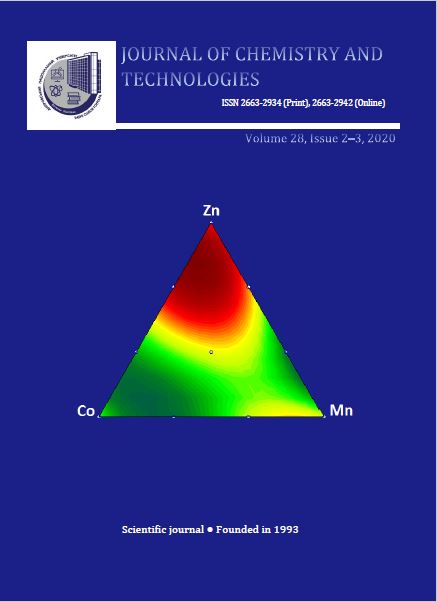SYNTHETIC FULVIC ACIDS FROM TANNIN
DOI:
https://doi.org/10.15421/082027Keywords:
tannin, fulvic acid, synthetic humic substancesAbstract
This research introduces a new, simple and effective method of producing synthetic fulvic acids from tannin. The synthesis is based on the reaction of tannin oxidation by pure oxygen in a highly alkaline environment. The conversion of fulvates to the acid was achieved by passing the resulting mixture through a cation-exchange column in the H-form. The resulting dark-brown product solution has a pH = 2. A complex study of the physicochemical and spectroscopic properties of the obtained product using the methods of elemental analysis, ultraviolet-visible, infra red and electron paramagnetic resonance spectroscopy, scanning electron microscopy, X-ray diffraction showed the similarity of the obtained product to natural fulvic acids. Synthetic fulvic acids are advantageous over natural humic substances due to their reproducible properties as a result of their strict synthesis conditions. This significantly expands the scope of their application, in particular in medicine, where one of the prerequisites is the standardization of properties.
References
Gomes de Melo, B. A., Motta, F. L., Santana, M. H. (2016). Humic acids: Structural properties and multiple functionalities for novel technological developments. Mater Sci Eng C., 62, 967–974.
https://doi.org/10.1016/j.msec.2015.12.001
Rigobello, E.S., Campos, S.X., Vieira, E.M. (2017). Comparative characterization of humic substances extracted from freshwater and peat of different apparent molecular sizes. Rev. Amb. Água., 12, 774–785.
https://doi.org/10.4136/ambi-agua.2022
Senesi, N., Xing, B., Huang, P.M. (Eds.). (2009). Biophysico-Chemical Processes Involving Natural Nonliving Organic Matter in Environmental Systems. John Wiley & Sons, Inc.
Kulikowska, D. (2016). Kinetics of organic matter removal and humification progress during sewage sludge composting. Waste Management, 49, 196–203.
https://doi.org/10.1016/j.wasman.2016.01.005
Eller, W. (1923). Studien über huminsäuren. IV. Darstellung und eigenschaften künstlicher und natürlicher huminsäuren. Liebigs Ann. Chem., 431, 133–161.
https://doi.org/10.1002/jlac.19234310108
Welte, E., Schatz, M., Ziechmann W. (1910). Über synthesehuminsäuren (Oxydationsmessungen) Naturwiss, 41 (9), 213–214.
https://doi.org/10.1007/BF00623027
Cataldo, F. (1998). On the structure of macromolecules obtained by oxidative polymerization of polyhydroxyphenols and quinines. Polym. Int., 46, 263–268. https://doi.org/10.1002/(SICI)1097-0126(199808)46:4<263::AID-PI983>3.0.CO;2-0
Cherepanov, I. S., Kryukova, P. S. (2020). Formation of humic substances in the reaction of D-glucose with p-toluidine in anhydrous ethanol. Proceedings of universities. Applied chemistry and biotechnology, 10 (2), 188–195.
https://doi.org/10.21285/2227-2925-2020-10-2-188-195
Sławińska, D., Polewski, K., Rolewski, P., Sławiński, J. (2007). Synthesis and properties of model humic substances derived from gallic acid. Int. Agrophys, 21, 199–208. https://doi.org/10.1007/s11356-018-1836-2
Litvin, V.A., Minaev, B.F., Baryshnikov, G.V. (2015). Synthesis and properties of synthetic fulvic acid derived from hematoxylin. J. Mol. Struct., 1086, 25–33.
https://doi.org/10.1016/j.molstruc.2014.12.091
Yang, T., Hodson, M. E. (2018). The copper complexation ability of a synthetic humic-like acid formed by an abiotic humification process and the effect of experimental factors on its copper complexation ability. Environmental Science and Pollution Research, 25, 15873–15884.
Hänninen, K.I., Klöcking, R., Helbig, B. (1987). Synthesis and characterization of humic acid-like polymers. Sci. Total Environ., 62, 201–210.
https://doi.org/10.1016/0048-9697(87)90502-X
Jung, A.-V., Frochot, C., Parant, S., Lartiges, B.S., Selve, C., Viriot, M.-L., Bersillon, J.-L. (2005). Synthesis of amino-phenolic humic-like substances and comparison with natural aquatic humic acids: A multi-analytical techniques approach. Org. Geochem., 36, 1252–1271.
https://doi.org/10.1016/j.orggeochem.2005.04.004
Giannakopoulos, E., Drosos, M., Deligiannakis, Y. (2009). A humic-acid-like polycondensate produced with no use of catalyst. J. Colloid Interface Sci., 336, 59–66.
https://doi.org/10.1016/j.jcis.2009.03.037
Laub, R. J. (1999). US Patent No. 5945446. Newport Beach, Calif.: US.
Wang, X., Muhmood, A., Dong, R., Wu, S. (2020). Synthesis of humic-like acid from biomass pretreatment liquor: Quantitative appraisal of electron transferring capacity and metal-binding potential. Journal of Cleaner Production, 255, 120243.
Ziechmann, W. (1960). Über modellreaktionen zur bildung synthetischer huminsäuren. 2. Die synthese von huminsäuren im neutralen milieu. Brennstoff-Chem., 41, 334.
Ikan, R., Dorsey, T., Kaplan, I. R. (1990). Characterization of natural and synthetic humic substances (melanoidins) by stable carbon and nitrogen isotope measurements and elemental composition. Anal. Chim. Acta, 232, 11.
https://doi.org/10.1016/j.orggeochem.2009.10.002
Matthiessen, A. (1995). Determining the redox capacity of humic substances Vom Wasser., 84, 229–235.
Hoyos-Martinez, P., Merle, J., Labidi, J., Bouhtoury F.C. (2019). Tannins extraction: A key point for their valorization and cleaner production. J. Clean. Prod., 206, 1138–1155.
https://doi.org/10.1016/j.jclepro.2018.09.243
Aires, A. (Ed.). (2019). Tannins: Extraction from Plants. UK, London: IntechOpen.
Machadoa, W., Franchini, J. C., de Fátima Guimarães, M, Filho, J.T. (2020) Spectroscopic characterization of humic and fulvic acids in soil aggregates, Brazil. Heliyon, 6(6), e04078.
https://doi.org/10.1016/j.heliyon.2020.e04078
Zhang, Y., Gong, G., Zheng, H., Yuan, X., Xu L. (2020). Synergistic Extraction and Characterization of Fulvic Acid by Microwave and Hydrogen Peroxide–Glacial Acetic Acid to Oxidize Low-Rank Lignite. ACS Omega, 5(12), 6389–6394.
https://doi.org/10.1021/acsomega.9b03796
Filcheva, E., Hristova, M., Nikolova, P., Popova, T., Chakalov, K., Savov, V. (2018). Quantitative and qualitative characterisation of humic products with spectral parameters. J. Soils Sediments, 18, 2863–2867.
https://doi.org/10.1007/s11368-018-2021-4
Struyk, Z., Sposito, G. (2001). Redox properties of standard humic acids. Geoderma, 102, 329–346. https://doi.org/10.1016/S0016-7061(01)00040-4
Downloads
Published
Issue
Section
License
Copyright (c) 2021 Днипровский национальный университет имени Олеся Гончара

This work is licensed under a Creative Commons Attribution 4.0 International License.
- Authors reserve the right of attribution for the submitted manuscript, while transferring to the Journal the right to publish the article under the Creative Commons Attribution License. This license allows free distribution of the published work under the condition of proper attribution of the original authors and the initial publication source (i.e. the Journal)
- Authors have the right to enter into separate agreements for additional non-exclusive distribution of the work in the form it was published in the Journal (such as publishing the article on the institutional website or as a part of a monograph), provided the original publication in this Journal is properly referenced
- The Journal allows and encourages online publication of the manuscripts (such as on personal web pages), even when such a manuscript is still under editorial consideration, since it allows for a productive scientific discussion and better citation dynamics (see The Effect of Open Access).


